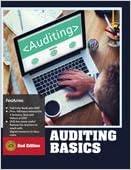Question
Suppose you were an auditor testing internal controls. The population is 2,000. The control you want to test is the requirement that any check of
Suppose you were an auditor testing internal controls. The population is 2,000. The control you want to test is the requirement that any check of more than $25,000 needs to be approved by two officials. Because of limitations in technology (i.e. the inability to use a machine to scan all checks for signatures), it is deemed too expensive to manually audit all 2,000 checks. Instead, we decide to rely on a random sample of 100 checks (i.e we will test 5 percent of the population). The auditor believes that up to 10 percent of all checks do not have the required controls, but that is ok. In other words, the auditor is willing to rely on the controls if the deviation rate is 10 percent, but not if the deviation rate is higher than 10 percent. The purpose of the audit will be to obtain evidence that the deviation rate in the population is no larger than 10 percent.
- Discuss the difference between the following terms (ex ante means before observing the sample evidence; ex post means after observing the sample evidence):
- Expected population deviation rate, ex ante
- Expected sample deviation rate, ex ante
- Observed sample deviation rate, ex post
- Expected upper limit of population, ex post
- Based on the information above, what is the expected ex ante sample deviation rate? Explain (not a trick question)
- Refer to Fact Pattern 1 below (on the following page, taken from MC E,F). Assume you take a sample of 100 observations and find that 7 observations out of 100 deviated from the required controls. Please refer to the description above which states that the auditor can live with a population deviation rate of 10 percent and still rely on the controls as generally effective. What can you say about the sample evidence? Is it sufficiently strong to allow the auditor to rely on the internal controls of the population? The answer is no, but please explain. Point to specific data in the table to support your answer.
- Would your answer differ if only 4 of the 100 observations in the sample indicated deviations from the controls? Explain.

Step by Step Solution
There are 3 Steps involved in it
Step: 1

Get Instant Access to Expert-Tailored Solutions
See step-by-step solutions with expert insights and AI powered tools for academic success
Step: 2

Step: 3

Ace Your Homework with AI
Get the answers you need in no time with our AI-driven, step-by-step assistance
Get Started


